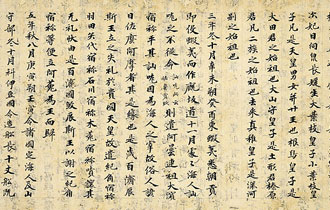Pages |
Linguistic Archaeology
Like many other types of words, borrowed words have their life cycles; some come into use like a supernova and fall into obsolescence quickly (e.g., above-mentioned biriibu-suru 'believe' and pashueedo-suru 'persuade' quickly went out of style). Blue pants made of special fabric came from the United States into Japan and these were called jiipan 'jeans, jean pants,' which came into popular use in the 1970s. Now this word may be a cause of raucous laughter among some youngsters. In their lingo, they are now called jiinzu. Here we see, in the last few decades, jiipan is being replaced by jiinzu. By tracing how words like these develop, one can do a type of linguistic archaeology, enabling one to guess at the speaker's age.
Use of Katakana
Katakana is now used to write onomatopoeic words, non-Chinese loanwords, and names of fauna and flora. Words borrowed fro non-Chinese sources have historically been written in katakana. "Historically" may not be the right word since this practice did not begin with any consistency until about late-19th century. This use of katakana generally holds true but borrowed words many centuries back have been totally assimilated into Japanese so much so that their foreigness was lost and began to be written in Japanese. Words like tabako (Portuguese tabaco 'tobacco'), tenpura (Portuguese temperado 'spiced' or tempero 'gravy, sauce' for a type of deep-fried dish), juban (Portuguese gibão 'undergarment') are frequently written in hiragana (or even in kanji) as in 煙草, 天婦羅, and 襦袢. Of interest is the word 煙草, which is the Chinese word for tobacco and is written precisely in this way and read in Japanese as tabako.
Kango and Wago and Lexical Stratification
One way to think of borrowed vocabulary and "native" Japanese vocabulary is to think of them as constituting layers, Japanese on the bottom and new additions on top. Native vocabulary and borrowed vocabulary perform different roles. It was noted earlier that the idea of the use of foreign words relates to erudition and authority. Borrowing from Chinese illustrates this principle nicely. Kanji compounds, either made in Japan or originally borrowed from China (called kango), account for more than 40% of today's Japanese vocabulary (about 50% of words in newspapers), making it the single largest category. Since China was a source of much advanced technology up until the mid-19th century, Chinese vocabulary is associated with technical fields, advanced education, high formality, etc. On the other hand, native Japanese vocabulary (wago) lack these attributes; it pertains more to daily life, informality, and low technical sophistication.
The status of Chinese influenced Japanese vocabulary much like that of Norman French (its vocabulary drew from Latin) which influenced the vocabulary of English. As a result of this French infusion, the lexical makeup of English changed dramatically in the 11th century. To appreciate the difference in flavor between homey Japanese (wago) and its formal, educated equivalent (kango), examine aruku 'walk' and hokō-suru (Chinese 'walk'). As a point of contrast, consider the difference in meaning and flavor between such pairs as walk (from wealcan 'wander' of Germanic origin) and ambulate (Latin ambulare 'walk').
Pages |











